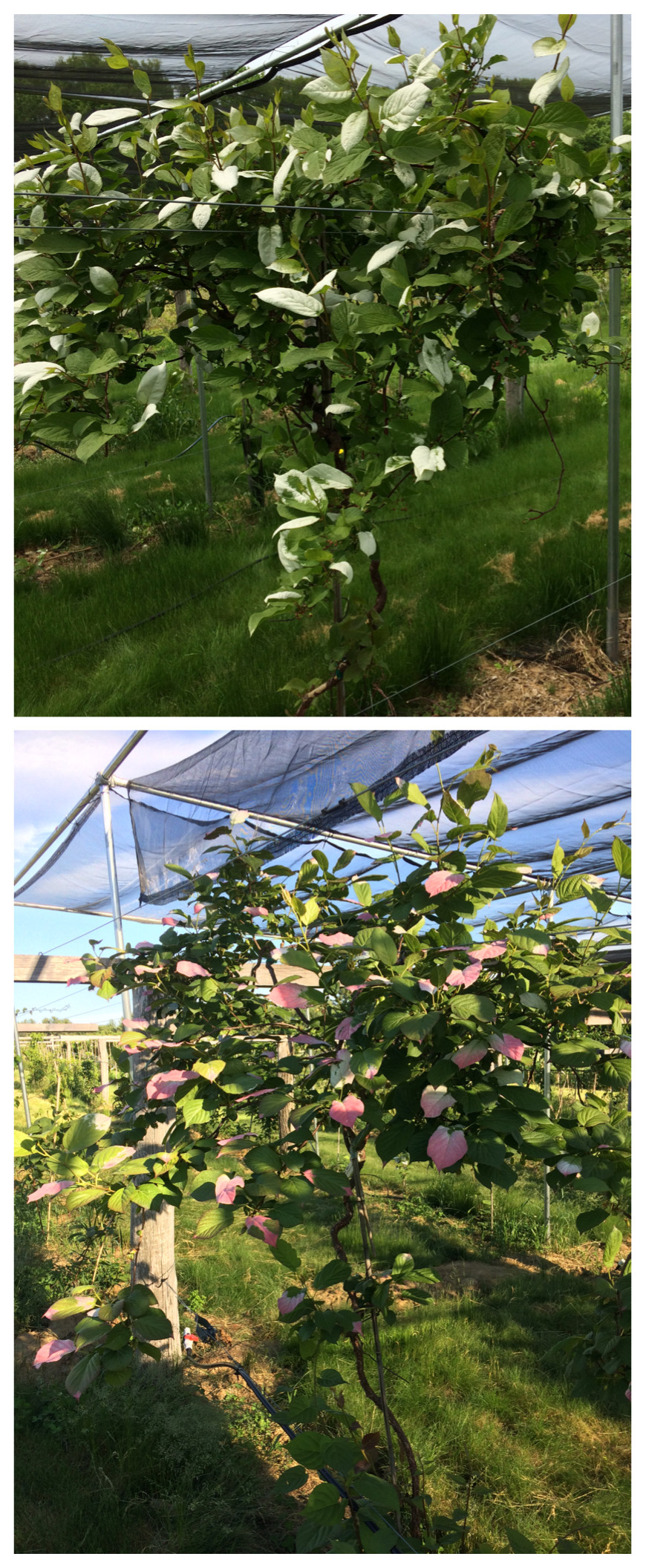Appendices
Appendix I
Grower resources
Appendix II
Federal import quarantine order for Pseudomomas syringae pv. actinidiae (Psa)
Appendix III
Statewide market analysis methodology and results
Appendix IV
Massachusetts Department of Agriculture (MDAR) decision letter (8/28/17)
Appendix V
Supplement on Actinidia kolomikta
Appendix VI
Areas of needed research
Appendix VII
Effects of harvest time and cold storage on the quality of berries of A. arguta cvs. ‘Ananasnaja’ and ‘Geneva 3’
Appendix VIII
Vineyard tasks, a seasonal timeline
Fig 1 Although they emerge and grow to full size completely green, the tender leaves of some varieties of A. kolomikta start to develop some patches of white on their upper surfaces just prior to flowering (top). Following flowering, portions of these white splashes flush hot pink in some varieties (bottom). Note the shade cloth above, protecting the vines from full sun exposure.
APPENDIX V
A word about A. kolomikta
Another option for Actinidia enthusiasts in the northeast is to try their hand at growing A. kolomikta. When fully dormant, this extremely cold-hardy kiwi species, often referred to ‘Arctic Kiwi’, is capable of withstanding temperatures down to -40°F. Actinidia kolomikta is a wonderful option for backyard gardens because the vines are much less vegetatively vigorous than A. arguta, requiring less space and far less management while still producing berries reminiscent of the kiwiberry. In general, our experience at the NHAES is that the berries of A. kolomikta, while quite tasty, have a less complex flavor profile that those of A. arguta, being primarily sweet without significant tartness. They are also in general smaller (notable exception: variety ‘Krupnoplodnaya’) and more delicate (thinner skin) than kiwiberries. In their favor, vines of this species appear to transition to maturity more quickly than those of A. arguta, with flowering occurring as early as Year 2. Another notable feature of some varieties of this species is the spectacular pink and white variegation that appears on the foliage during flowering (Fig 1), making A. kolomikta an attractive option as a climbing ornamental (males) or for incorporation into edible landscape design (males and females).
Vines of A. kolomikta will generally break dormancy, begin flowering, and produce physiologically mature berries 1-3 weeks before those of kiwiberry (A. arguta). While this does put them at greater risk of injury from late spring frost events, some varieties appear to be able to recover from such events with a second or even third flush of buds. While practically all training and production best practices for kiwiberry may be applied to A. kolomikta, vine spacing should be reduced to 5-8’ due to their comparative lack of vigor. Also note that this species in general has a higher shade requirement. If growing on any site exposed to full sun, especially in the afternoon, a shade cloth (~50%) is recommended to prevent sunburn, promote vigor, and achieve overall desired vine structure in a timely manner.
Despite its many good traits, our perspective at the NHAES is that commercial growers in the northeast should not attempt to produce A. kolomikta at scale due to the species’ low overall yields (as compared to current kiwiberry varieites), early break from dormancy, need for protection from full sun, and comparatively asynchronous ripening. The berries of A. kolomikta also exhibit poor pedicle adherence, meaning that fruits tend to drop on the ground once they reach maturity. There are, however, some notable exceptions to this (e.g. variety ‘Klara Zetkin’), and researchers at the Horticultural Research Center (HRC) at the University of Minnesota are making progress in eliminating this fruit-drop trait (R. Guthrie, pers. communication). Indeed, researchers at the HRC believe that A. kolomikta may have a place in commercial production. For example, although it is not nearly as productive as A. arguta, A. kolomikta is much easier to manage (lower pruning costs), comes into production more quickly, and has the potential to expand the harvest season. In southern Minnesota, the harvest season for the species now spans nearly three months, which could be an advantage to small growers catering to local markets. Lastly, despite its delicate, thin, nearly translucent skin, A. kolomikta shows no evidence of fungal colonization by sooty blotch or flyspeck; and HRC researchers are investigating the reason(s) for this, with potential impact on kiwiberry breeding more broadly.


